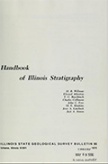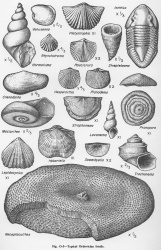Historical:Glencoe Member
Lithostratigraphy: Ottawa Limestone Megagroup >>Galena Group >>Decorah Subgroup >>Spechts Ferry Formation >>Glencoe Member
Chronostratigraphy: Paleozoic Erathem >>Ordovician System >>Champlainian Series >>Trentonian Stage
Allostratigraphy: Tippecanoe Sequence
Authors
H. B. Willman and T. C. Buschbach
Name Origin
The Glencoe Member of the Spechts Ferry Formation (Templeton and Willman, 1963, p. 110), which overlies the Castlewood Member, is named for Glencoe, St. Louis County, Missouri, which is 3 miles west of the type section.
Type Section
The type section of the Glencoe Member is the same as that for the Castlewood Member (near Castlewood, St. Louis County, Missouri (NE SE SE 21, 44N-4E)), where the Glencoe is 5.3 feet thick.
Extent and Thickness
The Glencoe Member is commonly 5-8 feet thick in the area near the Mississippi River, but it thins to the east.
Description
The most persistent and thickest Ordovician bentonite, commonly 1-3 inches thick and locally as much as 8 inches thick, occurs in the lower part of the Glencoe Member, interbedded with green, gray, or brown shale. Locally the bentonite is altered to a distinctive, hard, pink bed, which is almost entirely potash feldspar. The Glencoe is largely green shale, but it contains beds of calcarenite, greenish gray argillaceous limestone, and dark purplish gray coarse-grained limestone.
Fossils
Some beds of the Glencoe Member are a coquina of Pionodema subaequafa. In the Upper Mississippi Valley, the trilobite Isotelus gigas (fig. O-5) is common in an argillaceous limestone bed near the base.
References
TEMPLETON, J. S., and H. B. WILLMAN, 1963, Champlainian Series (Middle Ordovician) in Illinois: Illinois State Geological Survey Bulletin 89, 260 p.
ISGS Codes
| Stratigraphic Code | Geo Unit Designation |
|---|---|

